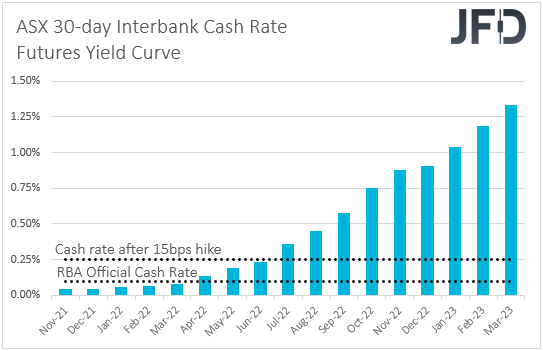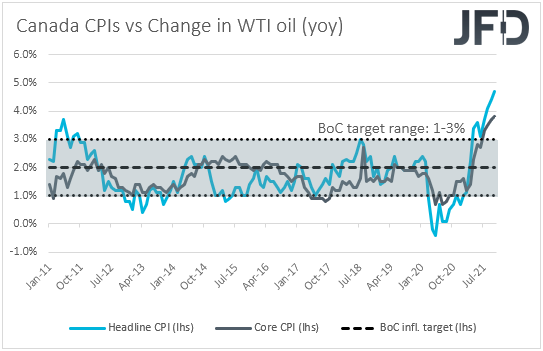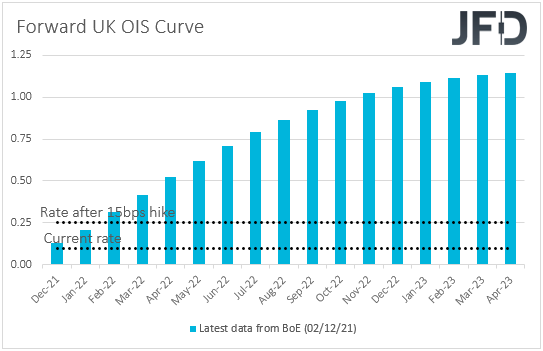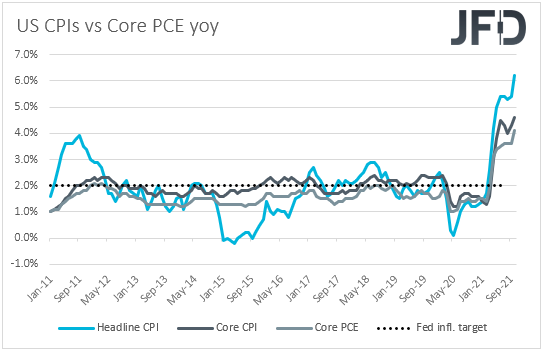We have two major central banks deciding on monetary policy this week: the RBA and the BoC. We expect the RBA to maintain its cautious stance and push back against interest rate hike expectations for next year.
On the other hand, the BoC will maintain an optimistic view and perhaps allow bets over a rate hike in the coming months to stay elevated. We have the CPIs for November in the US, where further acceleration could add credence to Fed Chair Powell’s view that QE tapering should end sooner than previously estimated.
Monday appears to be a relatively light day, with the only release worth mentioning being the UK construction PMI for November, which increased to 55.5 from 54.6. On Tuesday, during the Asian session, the RBA decides on monetary policy.
At their latest gathering, officials of this bank maintained their core policies – rates and QE – unchanged but decided to discontinue the 10 bps April 2024 yield target. They also abandoned the forward guidance that interest rates are most likely to stay intact until 2024 and suggested this could happen in 2023.

Since then, market participants remained convinced that policymakers could change their minds and perhaps deliver as many as three hikes during the following year, despite Governor Lowe making it clear that data and forecasts did not warrant an increase in 2022.
Data after the meeting showed that the unemployment rate jumped to 5.2% in October from 4.6%, with the economy seeing another month of lost jobs, while economic activity, although at a slower-than-expected pace, contracted in Q3.
All this, combined with slowing headline inflation in Q3, and underlying metrics near the lower end of the RBA’s 2-3% target range, suggests that officials are unlikely to appear more hawkish this time around. Having also in mind the slowdown in China, we would expect them to reiterate the view that no hikes are on the schedule for next year, which could eventually convince some market participants that this may indeed be the case.
Therefore, expectations on that front could get pushed back, which could result in further selling in the already wounded Aussie. The risk-linked currency has been driven mainly by broader market sentiment developments. As long as investors remain concerned over the new coronavirus variant and what economic implications new restrictive measures around the globe could have, we see the case for the latest downtrend to continue for a while longer. A cautious RBA could add extra fuel.
On Wednesday, the central bank torch will be passed to the BoC. At its latest meeting, this bank unexpectedly ended its QE program, maintaining an optimistic stance. Data since then showed that Canada’s labor market continued to improve in October and performed even better in November, with the economy adding much more jobs than the forecast suggested and the unemployment rate sliding to 6.0% from 6.7%.
The headline and core CPIs for October accelerated further above the upper end of the BoC’s target range of 1-3%, while GDP data revealed that the economy rebounded by much more than anticipated in Q3.

This data suggests that BoC could maintain an upbeat stance, allowing expectations that a hike could be looming in upcoming months to stay elevated. However, it remains to be seen whether the new coronavirus variant would affect policymakers’ stance.
It is too early for them to switch to a more cautious stance. They may prefer to wait for upcoming economic data before arriving at safer conclusions about the impact of the coronavirus and its new mutation. For now, we expect them to stay optimistic, something that could support the Loonie at the time of the release.
That said, with the broader sentiment staying subdued lately and oil prices turning down, this risk-linked currency could stay in downtrend mode as well. For now, we will treat any BoC-related rebound as a corrective bounce.
On Thursday, the only noteworthy data set, besides the US initial jobless claims, which we get every week, is China’s CPI and PPI for November. The CPI rate is expected to have risen to +2.5% YoY from +1.5%, while the PPI is forecast to have slid to +12.6% YoY from +13.5%.
Finally, on Friday, during the early European session, the UK releases its monthly GDP for October, alongside the industrial and manufacturing production rates for the month. There is no forecast for the monthly GDP rate, but the YoY rate is anticipated to have jumped to +22.2% from +6.6%.
Industrial production is expected to have rebounded +0.2% MoM after sliding 0.4%, while the manufacturing production rate is forecast to have held steady at +0.1% MoM.
Lately, due to fresh coronavirus-related worries, bets around a December hike by the BoE have declined, with most market participants now believing that officials may prefer to wait and act after the turn of the year. This, combined with the pound’s strengthening correlation with risk sentiment, has brought the currency under selling interest.
So, with that in mind, it remains to be seen whether upbeat data on Friday will be enough to revive some speculation over a December hike, and perhaps provide some support to the pound.
Later in the day, the spotlight is likely to turn to the US CPIs for November. The headline CPI is forecast to have accelerated further, to +6.7% YoY from +6.2%, while the core rate is expected to have increased to +4.9% YoY from +4.6%.

Last week, Fed Chair Jerome Powell appeared hawkish before the US Congress, surprising those expecting him to adopt a more cautious stance due to the new coronavirus variant and the restrictive measures adopted around the globe.
In contrast, the Fed Chief said that the “transitory” wording regarding inflation may have to be dropped out of the Fed’s monetary policy statement and that QE tapering should end sooner than previously estimated.
Despite nonfarm payrolls missing expectations on Friday, the unemployment rate declined even more, to 4.2% from 4.6%, and combined with further acceleration in the CPIs, it could add more credence to Powell’s view. Faster tapering could also mean faster rate hikes as well, and thereby a stronger US dollar.
However, how the equity market will react is not crystal clear. On the one hand, more investors may reduce their risk on expectations that higher rates sooner could hurt companies’ profitability. On the other hand, investors could buy more stocks as a strong report could underscore the strong performance of the US economy.
Even if the second proves true, as investors may have somewhat digested the idea of higher rates sooner, we will still not call for a long-lasting recovery. We will treat this as a corrective bounce. We stick to our guns that the uncertainty surrounding the Omicron variant could keep market participants reluctant to add risk to their portfolios for a while more, perhaps until the WHO gives official and justified answers with regards to the new coronavirus variant.
